Osteoporosis Yoga
Yoga helps improve balance for people with osteoporosis (2021, Dr. Caitlin McArthur, Registered Physiotherapist, PhD), improves health span (2022, Dr. Baxter Bell, MD), better posture, enhanced coordination, greater range of motion, higher strength, reduced levels of anxiety, and better gait (2015, Dr Loren Fishman, MD).
8 osteoporosis yoga tips :
- Practice yoga with a qualified Bone Fit™ trained Therapeutic Yoga Instructor like myself who has the training, knowledge and experience to modify poses to modify poses to make them safer to reduce the risk of fracture
- Share with your yoga instructor that you have osteoporosis.
- Give yourself permission to do the recommended modification to help prevent fractures.
- During yoga, focus on improving posture, creating space in your body, elongating the spine, your alignment, balance and slow controlled movements. Improved posture directly addresses spinal fractures, while all of these documented benefits of yoga reduce the risk of falling, which is the main cause of all other osteoporotic fractures,
- Laying down poses, if accessible to you, are great to help support your body better
- Chair Yoga. For over the past fifteen years, I have been teaching Chair Yoga for Healthy Aging (for those 55+) and Back Care Basics (for those 55+) and lovingly reminding participants the importance of taking the time to ensure they are in proper alignment, encourage a straight lengthened spines, modify bends and twists. The fact is, sitting puts a lot of pressure through the bones in the back which increases the risk of a fracture. Sitting and bending or twisting increases the risk even more. Adding weights is even more risky, especially if you have poor posture.
- Practice both statically and dynamically. When working statically, safely work up to 30 second holds, then safely and gradually up to 1 min, then up to 2 minutes. When working dynamically, work with your breath moving safely into and our of the pose , gradually working your way up to 6+ repetitions.
- Muscle Activation. In poses, For example, in tree pose consciously and gently firm muscles toward the bone vs bulging out your muscle in standing leg. Then working to firm up other muscles in the body.
To do any active yoga pose, you contract certain muscles to enter in and out of the pose as well as to hold it, These muscles contractions are lengthening, toning and strengthening your muscles, This in turn allows you to hold poses longer and provides you the strength you need for your everyday activities and other activities you enjoy. Practicing longer sessions, helps to increase your endurance as well.
Weight bearing yoga positions on the feet, hands and sitting bones naturally helps maintain bone strength. Dr Loren Fishman’s ten year (2005-2015) study on yoga for osteoporosis showed 30 second holds can be effective to build bone strength. Cautionary note, gradually and safely build up to 30 seconds or more.
Yoga strengthening poses can help maintain bone density. However, to date, there is still not enough good evidence to say that yoga improves bone mineral density (2021, Dr. Caitlin McArthur, Registered Physiotherapist, PhD).
For those living with Osteoporosis, the bones at greatest risk are mid spine (thoracic), followed by wrist bones and thigh bones at the hip joint Dr Baxter Bell, MD and Nina Zolotow (2017, Yoga for Healthy Aging). For healthy aging, muscle and bone strength are equally important! Muscle weakness can compromise our ability to balance, increase the risk of falls.
Caution if you have Osteoporosis:
Avoid flexion of the spine, especially mid (thoracic) spine, and use caution with deep rotation of the spine (2017, Dr Baxter Bell, MD)
Dr. Caitlin McArthur (2021) warns hot yoga may cause people to overstretch into unsafe positions and should be avoided for people with osteoporosis.
Sources:
Dr Baxter Bell, 2017 Yoga for Healthy Aging Book (pg 32-37, 293)
Dr. Caitlin McArthur, Registered Physiotherapist, PhD highlighted 2021 article https://osteoporosis.ca/oc-blog/yoga-and-osteoporosis-suggestions-for-safe-and-appropriate-practice
Dr Loren Fishman, MD, 2015 (Ten Year research) Twelve-Minute Daily Yoga Regimen Reverses Osteoporotic Bone Loss https://www.ncbi.nlm.nih.gov/pmc/articles/PMC4851231/
May 12th, 2023 Challenge
to decrease low back pain and decrease the lean forward when seated, walking and standing.
1. Sitting with support under bum bones
On a flat chair, place a folded blanket or beach towel; thinker part at the back for under the bum bones and gradually decrease forward under your legs. .
=============
Dr Loren Fishman’s 2005 Osteoporosis Yoga Series
Yoga poses specifically for their safety and their calculated effects on those 3 sites (spine, hip, and femur) the most commonly fractured.
Result: 30+ second holds can be effective to build bone strength. Gradually and safely build up to 30 seconds or more.
The 12 yoga poses studied here appear to be a safe and effective means to reverse bone loss in the spine and the femur and have weaker indications of positive effects on the total hip measurement of the DXA scan. There is qualitative evidence suggesting improved bone quality as a result of the practice of yoga.
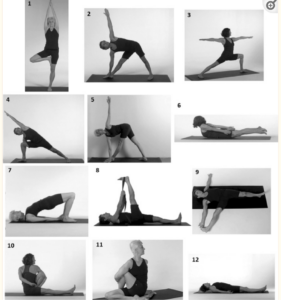 (1) Vriksasana—tree,
(1) Vriksasana—tree,
(2) Trikonasana—triangle,
(3) Virabhadrasana II—warrior II,
(4) Parsvakonasana—side-angle pose,
(5) Parivrtta Trikonasana—twisted triangle,
(6) Salabhasana—Locust,
(7) Setu Bandhasana—bridge,
(8) Supta Padangusthasana I—supine hand-to-foot I,
(9) Supta Padangusthasana II—supine hand-to-foot II,
(10) Marichyasana II—straight-legged twist,
(11) Matsyendrasana—bent-knee twist,
(12) Savasana—corpse pose.
One of the most common questions I get from people with a new diagnosis of osteoporosis is can I do yoga? Yoga is defined as “a system of physical postures, breathing techniques, and sometimes meditation derived from yoga but often practiced independently especially in Western cultures to promote physical and emotional well-being.” While yoga has many benefits to mind, body and spirit, there are some postures that might not be safe for people with osteoporosis.
Some people may be worried about the yoga practice they have been doing for many years, while others may be wondering about starting yoga to become more active. Below you will find general guidelines for people thinking about starting yoga and those who have some experience, including what to look for in a yoga class and instructor.
THE RISKS AND BENEFITS OF YOGA FOR PEOPLE WITH OSTEOPOROSIS
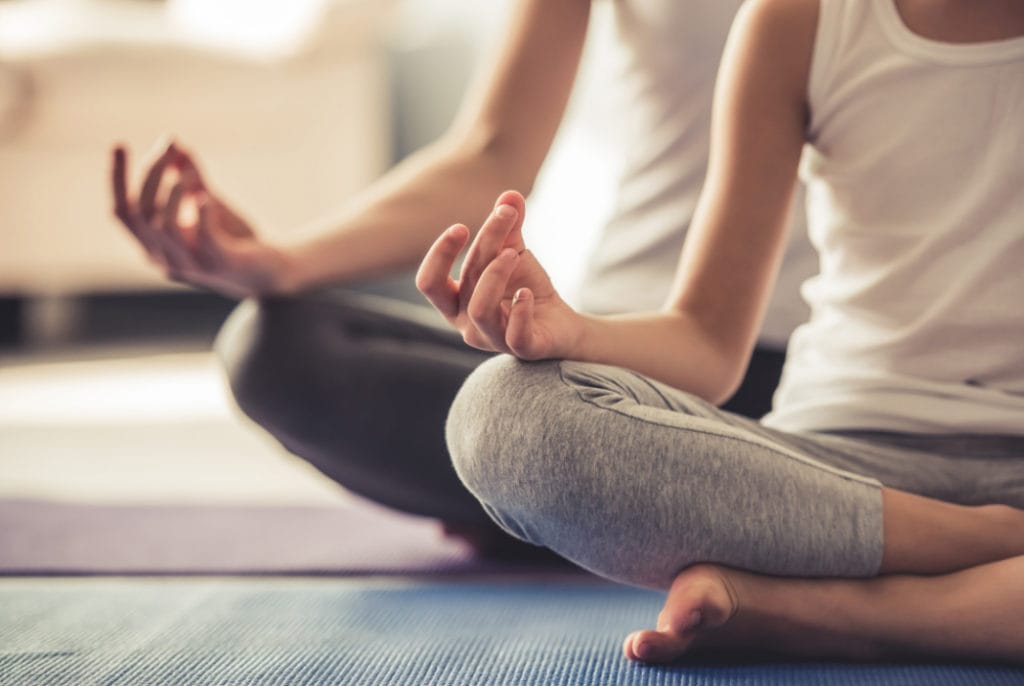
Like all activities, there are risks and benefits of practicing yoga. One risk of yoga can be to experience a fracture.
A fracture could happen when you are doing movements that could pose a risk such as the seated twist and pigeon pose, or if you were to fall. There have been case reports of people with osteoporosis experiencing fractures during yoga. On the other hand, yoga may benefit your quality of life and has been shown to improve balance for people with osteoporosis. However, there is not enough good evidence to say that yoga improves bone mineral density. Based on your own health and abilities, you need to decide if practising yoga is right for you. If you decide yoga is right for you, you also need to be sure to modify riskier positions.
OVERALL PRINCIPLES FOR A SAFE YOGA PRACTICE WITH OSTEOPOROSIS
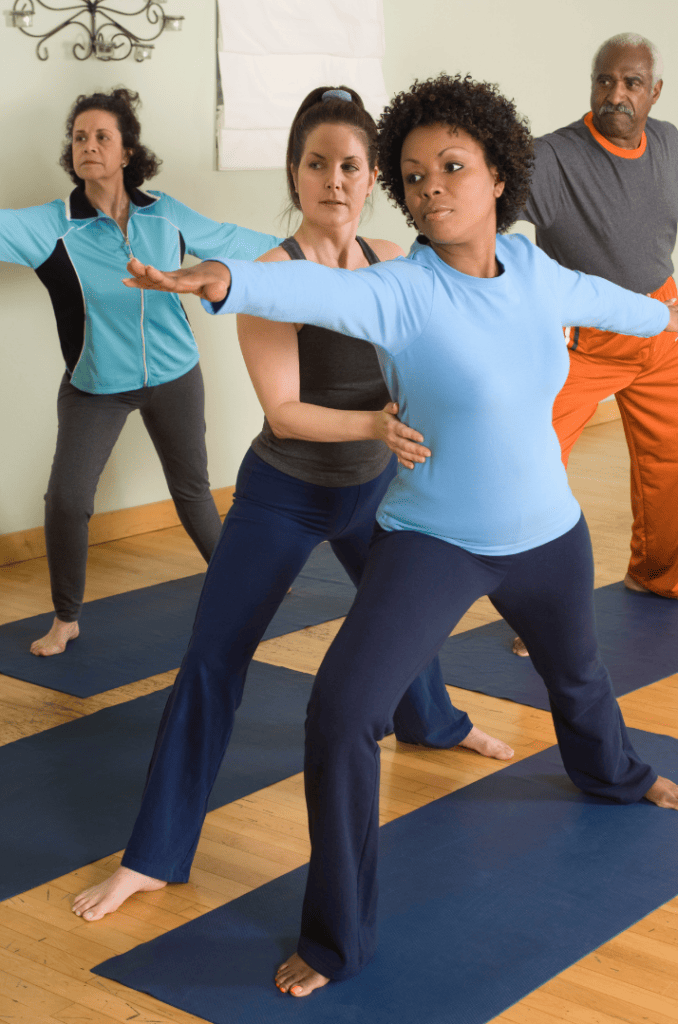
Tip 1: Consult a physiotherapist if you are new to yoga, have a history of spine fractures, or you are feeling uncertain about what to do. It is especially important to find a physiotherapist who has training for working with people with osteoporosis. Bone Fit™ is a training program for exercise professionals, like physiotherapists, who work with people with osteoporosis. You can find a Bone Fit™ trained physiotherapist using the Bone Fit™ locator by visiting the website.
Tip 2: Seek out a yoga class designed for people with osteoporosis and other health conditions (e.g., osteoarthritis) and ensure your instructor has proper training for working with this population. Yoga instructors can also become Bone Fit™ trained
Tip 3: Make sure your yoga instructor knows you have osteoporosis so they can give you the appropriate modifications throughout the class. If they don’t know, they won’t be able to help you practise safely.
Tip 4: Focus on controlled movements and less on intensity of the postures. Yoga is not about competition between you and the person on the mat beside you, so work at your own level and pace. Injuries can occur when you try to force yourself into extreme positions.
HERE ARE SOME THINGS YOU CAN THINK ABOUT THROUGHOUT YOUR YOGA PRACTICE TO HELP KEEP YOU SAFE:
Keep your balance steady: Focus on one point with your eyes and maintain firm contact with a support object (wall, ground, steady chair) with your feet and/or hands.
Keep good alignment: Try to keep your spine as tall, lengthened and as straight as possible throughout each posture and transitions between postures.
For more information on exercise for bone health and managing osteoporosis click here.

WRITTEN BY
Dr. Caitlin McArthur
Registered Physiotherapist, PhD
As featured in COPN’s Unbreakable Issue 13
YOGA AND OSTEOPOROSIS: SUGGESTIONS FOR SAFE AND APPROPRIATE PRACTICE – PART 1
YOGA AND OSTEOPOROSIS: SUGGESTIONS FOR SAFE AND APPROPRIATE PRACTICE – PART 2
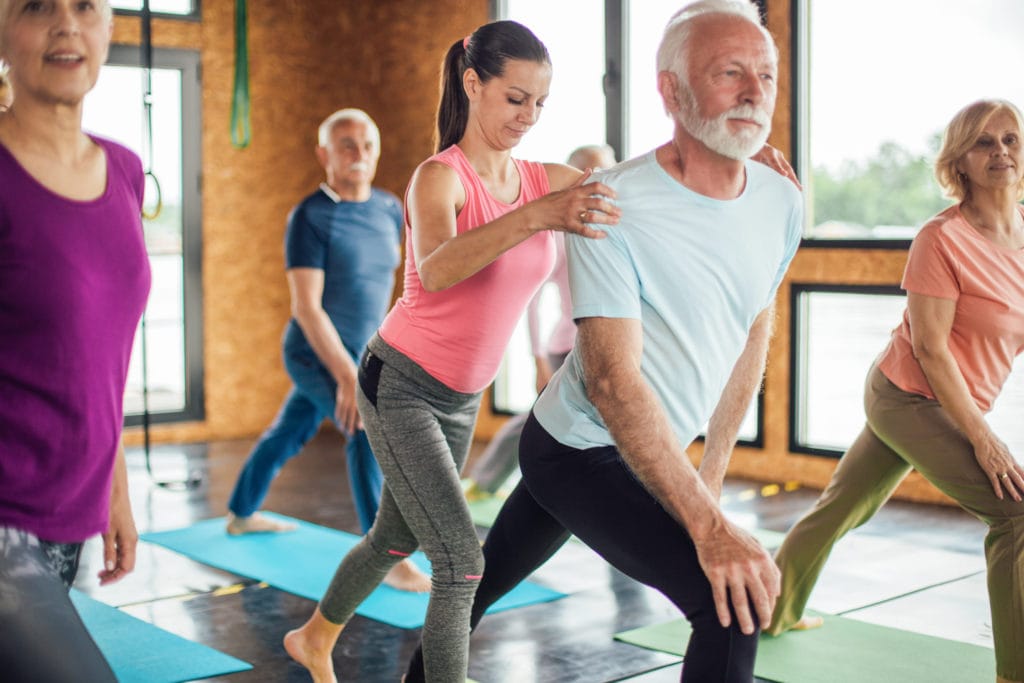
Yoga has many benefits to mind, body and spirit. But for someone with osteoporosis or at risk of a broken bone, there are some movements that should be modified or avoided.
YOU SHOULD MODIFY ANY POSTURES OR MOVEMENTS THAT:
- make you bend your spine forward, backward or twist as far as you can (example: rag doll)
- are done in sitting (example: seated twists)
- force your hip into full rotation (example: pigeon)
- are repetitive (doing a movement over and over – example: rolling like a ball)
- rapid (moving quickly – example: jumping your feet to your hands from downward facing dog)
- weighted (holding a weight or something heavy while you do the movement – example: Russian twist with a dumbbell)
- any of the above in combination (e.g., repetitively bending forward as far as you can)
Sometimes it is not the end position that is the problem, it is how you get in and out of the position. For example, downward facing dog encourages a straight back and is a safe posture to do with osteoporosis – but, it is dangerous for your spine to get out of the posture by jumping your feet to your hands and rolling up through your spine.
A better way to transition out of downward facing dog is to drop to your knees. Come into standing by bringing one foot forward into a kneeling position and push up into standing, keeping your back tall and straight. If that is difficult or your balance is wobbly, then do it next to a wall or very sturdy chair. Downward facing dog is best done with a qualified yoga instructor to make sure it is done correctly.
You need to modify these movements because they put a lot of pressure on your spine and hip bones in ways that increase your risk of breaking a bone. Since osteoporosis already makes your bones more likely to break, you should try to decrease any other factors that could cause them to break. Modifying the movements listed above may help decrease your risk for a broken bone when practising yoga.
Here are some suggestions for yoga postures to continue to do, to avoid and to modify. This is not an exhaustive list but will help give you an idea of what you might need to start or stop doing. If you are uncertain, contact a physiotherapist for advice.
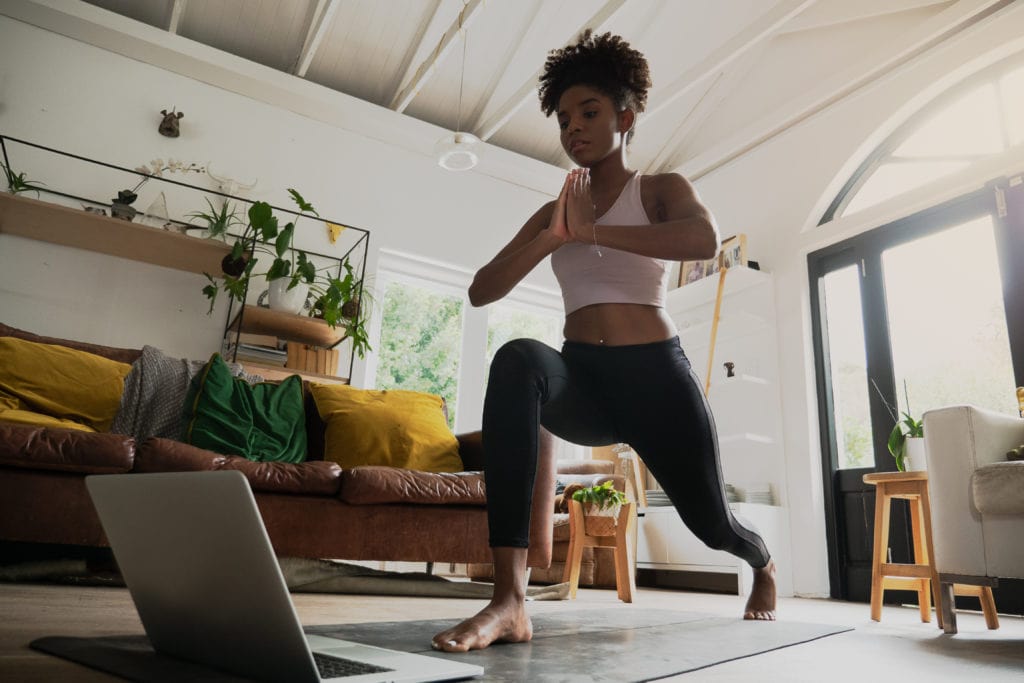
YOGA POSTURES YOU CAN CONTINUE TO DO WITH PROPER INSTRUCTION AND GUIDANCE
- Corpse
- Bridge
- Warrior
- Mountain
- Chair
- Crocodile
- Sphinx
- Locust
YOGA POSTURES YOU SHOULD AVOID:
- Spinal rocking
- Rag doll
- Saw
- Plow
- Pigeon
YOGA POSTURES YOU SHOULD CONTINUE TO DO WITH PROPER GUIDANCE, INSTRUCTION AND MODIFICATIONS:
- Twists – don’t go as far as you can, do them lying down instead of sitting: in a knees-down twist lying on your back, rest your knees on a nearby wall or folded blanket so you don’t go too far
- Child’s Pose – put a yoga block under your head or place your forehead on stacked fists to avoid a rounded back
- Thread the needle – do it lying on your back, keep your head down on the ground to avoid a rounded back
What about props? Props should only be used when they help you make the posture safer or more aligned but shouldn’t be used to help push you further or deeper into a position. For example, you could use a sturdy chair to help you do a modified downward facing dog, but you shouldn’t use a yoga strap to help pull you further into a forward bend.
Chair yoga may be appropriate in some situations but could increase the risk for spine fracture if not done carefully. If you are very unsteady on your feet or are unable to get down to the ground, then chair yoga could be an option. However, you must be very cautious about alignment since all the yoga postures in chair yoga will be done in a seated position. Sitting puts a lot of pressure through the bones in the back, increasing the risk for a broken bone. Sitting and bending or twisting increases the risk even more. If you are doing chair yoga, you should be especially careful to modify bending or twisting the spine and focus more on postures that encourage a straight or lengthened spine. Standing or lying down are better positions to be in if they are safe for you. Hot yoga can cause people to overstretch into unsafe positions and should be avoided for people with osteoporosis.
With the guidance of an exercise professional who is trained to work with people with osteoporosis, yoga can be safe, beneficial and enjoyable. Remember to seek out a yoga instructor that has training to help you make modifications and a class that is appropriate for you, and to practise at your own level.
For more information on exercise for strong and healthy bones click here.

WRITTEN BY
By Dr. Caitlin McArthur
Registered Physiotherapist, PhD
As featured in COPN’s Unbreakable Issue 14
Recent Posts
- Setting Positive Intentions Inspired by Yogic Wisdom
- 10 Steps: How to Navigate Stormy Seas – Guiding principles to help you land onto safer shores
- Celebrating Global Yoga Therapy Day – A Journey of Healing and Empowerment
- Chair Yoga for Healthy Aging: Promoting Independence, Well-Being, and Mental Clarity
- Sleep Solutions: Empowering Restful Nights for Older Adults, Concussion Recovery, Back Pain, and Mental Health


